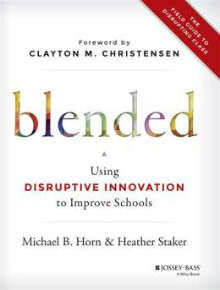A Revolutionary Look at Blended Learning
Blended: Using Disruptive Innovation to Improve Schools
By Michael B. Horn and Heather Staker
(Jossey-Bass, 2014 – Learn more)
Reviewed by Mackenzie Grate

Opening this book was like was like peering into the future of education. Needless to say, I was inspired to read on!

Blended: Using Disruptive Innovation to Improve Schools shares concrete steps one can take to design or redesign a school and use technology to customize its programming and meet the unique challenges that a specific school community faces.
No time wasted with glitz and bling
Rather than starting with the expected “glitz” and “bling” of the tech options that are available, Horn and Staker intentionally hold off on those specifics and instead set the reader up with a nice amalgam of theory and practice.
A great deal of time is spent defining the different models of blended learning and analyzing their benefits and drawbacks. While exemplars are presented, the authors make clear that this innovative approach is only in its nascent stage and will continue to evolve as more technological advances are achieved and more educators experiment and adapt their instruction accordingly.
There is also a push from the authors, challenging schools to rigorously examine their own specific community needs and to be diligent and intentional when adopting, adapting and refining these strategies to meet the needs of the particular students they serve.
The book even provides a website with short videos of various schools that have adopted or created hybrids of blended learning models. Horn and Staker sprinkle links to these online videos throughout the book to aid the visual learner who may be struggling to envision ideas in practice. My only hesitation is that many of the videos appear to be rather rosy, promotional products rather than authentic depictions of school transformation from an insider’s point of view.
Resonating points from the book
Schools need to be designed through the perspective of kids, but meet the needs of all stakeholders. Although change theory is not directly mentioned in this book, it is implied as necessary to understand blended learning models and and pursue widespread adoption.
Blended learning is less about the tech used to deliver the information to students and more about the mental shift that educators must make to release control back to the students so that they can be empowered by own learning. Traditional schools as they stand are limited in their level of student-centered instruction. Blended learning can be the disruptive innovation that leads to much-needed restructuring, if implemented thoughtfully.
Teachers often fear tech because they are apprehensive that it will diminish their role down the line. If teachers could get past this irrational fear, they would see that their role will not be eliminated but simply transformed from being the deliverer of information to the facilitator, coach, mentor and partner in this educational journey.
Teaching is a profession built on relationships, and that is a foundation that technology can never replace. If teachers, on a large scale, begin to shifting their mental models of what a “proper” role for educators looks like, then the education revolution will really begin.
The final takeaway worth mentioning is this that book challenges educators to engage in entrepreneurial leadership, an approach that has typically been reserved for the private sector. It challenges leaders to reimagine what is possible in a school. It defies many common assumptions that policy makers, principals and teachers make, ranging from the scheduling of classes to the role of the teacher to the physical design of schools.
Blended left me wondering: If I had never experienced schooling before in our society, what would I create?
Final Verdict
Although I picked this book up initially to learn more about how to infuse technology into my teaching, I ended up getting a much broader vision for how blended learning is impacting our mental models about schooling today. It gave me a new perspective on 21st century learning and how it can be achieved on a mass scale.
While Horn and Staker offered some ideas that I can implement in my classroom, what I will really take away and keep is the big idea of disruptive innovation. Blended is definitely worth a read, especially if you aspire to be a revolutionary school building or district leader one day.
Mackenzie Grate has been an ELA teacher leader in New York City middle schools for the past eight years. She has a BA in English Education and an MS in TESOL from New York University and is currently earning an MA in Educational Leadership from The College of Saint Rose. Her hope is to one day open a school with her colleagues based on a collaborative teacher leadership model. Follow her on Twitter @ThisTeacherSays and at MackenzieGrate.com. Grate’s story about disruptive innovation in her own middle school, resulting in a comprehensive academic coaching program, can be found here at MiddleWeb.



































